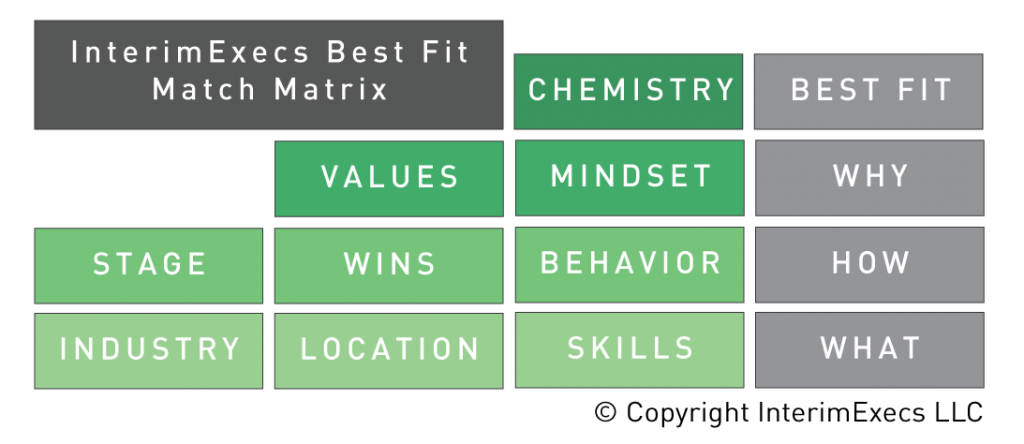How do you know whether an interim executive will be the right fit for your company’s needs? Ultimately, that’s an individual decision that depends on your company. But generally, when we get a call from an executive, head of human resources, small business owner, or private equity investor, it’s because the organization is in motion. Leadership to drive growth, change, or turnaround is needed. And it’s needed fast.
If you are tasked with bringing in an interim executive, you’ve probably done your research and understand what a true interim executive is, believe you need more than a consultant, and have an idea of how an interim gets compensated.
But still – is contracting with an interim executive the right move for you and your company?
Let’s explore:
6 Tough Questions to Ask Yourself
Sometimes the toughest thing to do is look in the mirror and assess: Where are you at as an organization? Where are the gaps? Where does your leadership team need a boost?
InterimExecs’ RED Team approach begins with a conversation to explore your starting point, where you want to go, and what kind of leadership will get you there.
Ask yourself these tough questions:
- How does current leadership match up with what’s needed for future progress?
- Does your management team have the bandwidth to take advantage of untapped opportunities for growth?
- Is your plan clear, and is the team aligned?
- Do you have a clear handle on challenges in operations, finance, technology, sales, and marketing?
- When you look back on the past year – was the company able to execute on goals?
- Are you happy with your progress?
If the answers to any of those questions show the company is falling short, an experienced operating executive can bring a no-nonsense, cut-to-the-chase outside perspective that can jumpstart progress.
Evaluate Your Goals and Project List
In some situations, you may need to bring in an interim to work on a specific project or initiative that could benefit from additional resources. The interim assignment may consist of one executive engaged on one specific project, or could involve a team engaged on a complex multifaceted project or set of deliverables.
Areas where RED Team interim executives excel include:
- Turnaround when a company or division is in distress, losing money, or slipping in market share or revenue decline. (Read More: 5 stages of a successful turnaround.)
- Liquidation when assets are being repurposed, recapped, spun off, or sold off.
- Operational improvement requiring new processes, systems, and/or controls.
- Preparing a company or division for a transformative event, including spinoff, carve out, investment, sale, merger, or IPO.
- Revenue enhancement, including sales and marketing system upgrades, training, hiring, and new business development.
- New market creation, including new product development and design, international expansion planning and execution, brand positioning, and social media and awareness.
Determine if You Are Ready for Change
You are selective about who you bring into your organization – and so are we. We have to be very picky about which clients we choose to work with. Beyond determining if an organization is honest and forthcoming about the situation, we want to know if there is serious intent to take on the organization’s challenges and opportunities.
Not that the interim will expect everyone to be on board or ready for change. Things may be tense or fragile depending on how deep the issues or challenges run. This is where we can say with confidence: Do not fear – it’s the job of the operating executive to learn fast, listen well, assess with accuracy, work to gain trust with the team, communicate clearly, develop a clear vision, and work to align the team.
Interim Does Not Equal Permanent
Contracting with a great interim, project, or fractional executive is different from hiring a new permanent exec. Headhunter work is one and done: source a candidate and get them hired, or move on to the next candidate.
At InterimExecs, our rock star executives have dedicated their careers to interim, project, or fractional leadership roles where they have a track record of success across many different organizations.
Fifteen years of focus on connecting interim executives with companies in need has allowed us to develop a unique process. We look not just at resumes or backgrounds but dive into the unique mindset of an interim. That gives us confidence in their ability to bring positive results to companies over and over again.
By rigorously screening executives, we concentrate on just the top 2% of leaders – what we call the RED Team (Rapid Executive Deployment). RED Team executives have experience across specialties (CEO, CFO, COO, CIO, CTO) and industries (manufacturing, services, healthcare, technology) that can be deployed individually or as a team.
And, because the executives have been thoroughly vetted, we can have someone on-site in as little as 48 hours.
So how do you know if your best route is interim versus a permanent search?
Moving Forward
The challenge comes with companies that set a great path forward, then become paralyzed.
Remember Circuit City? Or Blockbuster? The writing was on the wall. Evolution and innovation needed to happen to survive, yet these big brands like many organizations got stuck, seemingly with no way out.
Interim executives are the very definition of change agents. There is always a way. The first step is acknowledging that what worked in the past won’t necessarily take you into the future.
Interims drive transformation, change, and improvement. Even if it’s a short-term assignment lasting only until the permanent executive is brought in, a true interim executive seeks to leave the organization and team in a better place than when they walked in the door.
Still serious about making an impact in your organization? Let’s talk. We can have a RED Team executive deployed in as little as 48 hours to begin transforming your organization.







